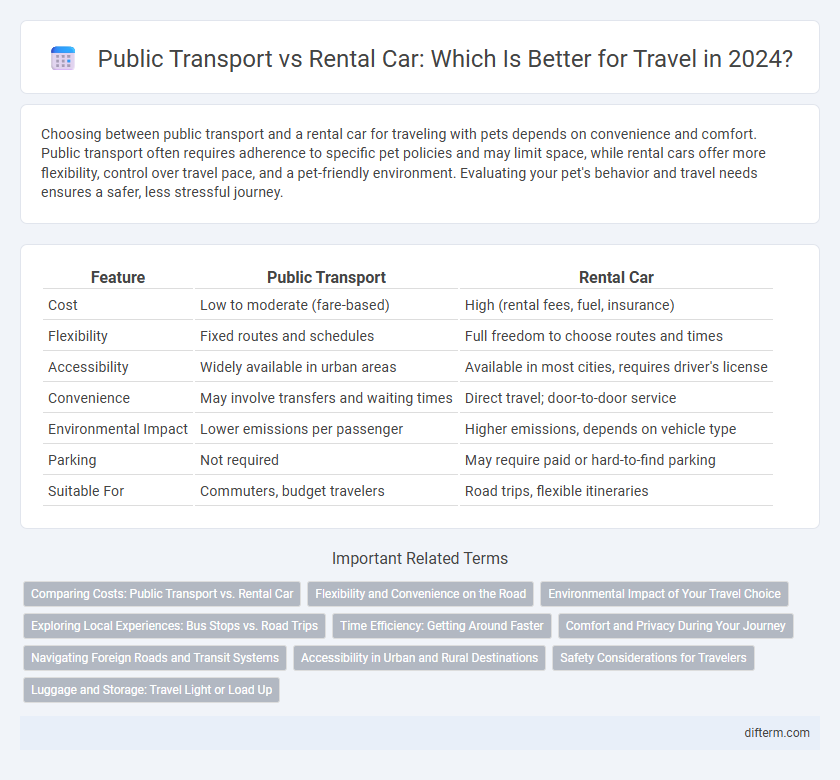Choosing between public transport and a rental car for traveling with pets depends on convenience and comfort. Public transport often requires adherence to specific pet policies and may limit space, while rental cars offer more flexibility, control over travel pace, and a pet-friendly environment. Evaluating your pet's behavior and travel needs ensures a safer, less stressful journey.
Table of Comparison
| Feature | Public Transport | Rental Car |
|---|---|---|
| Cost | Low to moderate (fare-based) | High (rental fees, fuel, insurance) |
| Flexibility | Fixed routes and schedules | Full freedom to choose routes and times |
| Accessibility | Widely available in urban areas | Available in most cities, requires driver's license |
| Convenience | May involve transfers and waiting times | Direct travel; door-to-door service |
| Environmental Impact | Lower emissions per passenger | Higher emissions, depends on vehicle type |
| Parking | Not required | May require paid or hard-to-find parking |
| Suitable For | Commuters, budget travelers | Road trips, flexible itineraries |
Comparing Costs: Public Transport vs. Rental Car
Public transport offers a significantly lower cost per trip compared to rental cars, especially in urban areas where daily fares range from $2 to $5, while rental cars average $40 to $70 per day plus fuel and parking fees. Rental cars provide flexibility and convenience for exploring remote destinations but entail additional expenses such as insurance, fuel, tolls, and depreciation. Evaluating the total travel distance and itinerary complexity is crucial for travelers to determine whether the economic benefits of public transport outweigh the autonomy provided by a rental car.
Flexibility and Convenience on the Road
Rental cars offer superior flexibility by allowing travelers to explore remote destinations and travel on their own schedule without reliance on public transport timetables. Public transport provides convenience in urban areas with established routes and affordable fares, but may limit access to off-the-beaten-path locations. Choosing a rental car enhances freedom and spontaneity for road trips, while public transport ensures hassle-free navigation in well-connected cities.
Environmental Impact of Your Travel Choice
Choosing public transport significantly reduces your carbon footprint by lowering greenhouse gas emissions per passenger compared to rental cars. Public transit systems, such as buses and trains, utilize energy-efficient technologies and often run on renewable energy sources, minimizing environmental damage. Rental cars typically produce higher CO2 emissions, contributing to air pollution and climate change, especially when used extensively during travel.
Exploring Local Experiences: Bus Stops vs. Road Trips
Exploring local experiences by using public transport offers immersive interactions at bus stops, where travelers encounter authentic street life, diverse vendors, and spontaneous conversations with residents. Rental cars enable flexible road trips, providing access to remote attractions and scenic routes often missed by buses, enhancing personalized adventure and discovery. Choosing between the two depends on a desire for cultural engagement through community hubs or freedom to explore off-the-beaten-path destinations in depth.
Time Efficiency: Getting Around Faster
Public transport often adheres to fixed schedules and designated routes, which can lead to longer travel times due to frequent stops and transfers. Rental cars provide greater flexibility, allowing travelers to choose the fastest routes and make spontaneous detours, significantly reducing overall travel time. In urban areas with heavy traffic congestion, rental cars equipped with real-time GPS navigation can optimize routes, further enhancing time efficiency compared to relying on public transit systems.
Comfort and Privacy During Your Journey
Choosing a rental car enhances comfort and privacy by offering a personalized space where travelers control the environment, including temperature, music, and seating arrangements. Unlike public transport, rental cars eliminate close physical proximity to strangers, reducing noise and distractions for a more peaceful journey. This personalized control significantly improves the overall travel experience, especially during long trips or when privacy is essential.
Navigating Foreign Roads and Transit Systems
Navigating foreign roads requires understanding local traffic laws, road signs, and driving customs, which can be challenging without prior experience. Public transport systems offer a cost-effective and eco-friendly way to access major attractions, often with clear route maps and multilingual support for tourists. Rental cars provide flexibility and convenience for exploring remote areas but demand careful planning to avoid traffic violations and parking difficulties in unfamiliar cities.
Accessibility in Urban and Rural Destinations
Public transport systems in urban areas offer extensive accessibility with frequent stops, diverse routes, and affordable fares, making them convenient for tourists navigating city centers. Rural destinations often lack comprehensive public transport options, where rental cars provide essential mobility and greater access to remote attractions. Choosing between public transport and rental cars depends on the destination's infrastructure and the traveler's need for flexibility and ease of movement.
Safety Considerations for Travelers
Public transport systems often maintain rigorous safety protocols, including regular vehicle maintenance and trained staff, reducing risk for travelers in urban areas. Rental cars provide greater control over vehicle cleanliness and driver behavior but require travelers to navigate unfamiliar roads and local traffic laws, which can increase accident risk. Choosing between public transport and rental cars depends on the destination's infrastructure, personal driving experience, and comfort with local traffic conditions to maximize traveler safety.
Luggage and Storage: Travel Light or Load Up
Public transport offers limited storage, making it ideal for travelers who pack light and prefer mobility without the hassle of managing bulky luggage. Rental cars provide spacious trunks and flexible storage options, accommodating larger bags and multiple pieces, which is perfect for extended trips or family travel. Efficient luggage management influences travel comfort and convenience, with car rentals enabling personalized space optimization often unmatched by buses or trains.
public transport vs rental car Infographic

 difterm.com
difterm.com